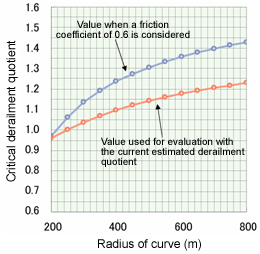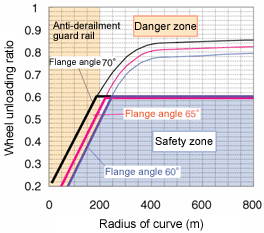|
The RTRI performed creep force characteristics tests, derailment running tests in the RTRI compound, vehicle running simulation and friction coefficient surveys on revenue service lines, clarified the mechanisms from wheel-climb to derailment, and quantified various influencing factors. Based on the results obtained from these processes, the RTRI proposed techniques to evaluate the safety of train operation in (1) desk discussions and (2) low-speed running tests.
Based on the data obtained from the derailment running tests performed in its own compound, the RTRI verified the appropriateness of the formula to estimate the attack angle and the model to set the lateral pressure to wheel load ratio on the inner rail side, which is used to estimate the wheel load and lateral pressure. The RTRI also calculated the critical derailment quotient by using the relationship between the attack angle and creep force values obtained from creep force characteristics tests (Fig. 1). It was shown that the safety of train operation could be ensured by applying the current evaluation technique using the estimated derailment quotient intact for theoretical safety evaluation, even when the friction coefficient increased.
As an evaluation method in field tests where it is difficult to control the friction coefficient between wheel and rail, the RTRI proposed using the wheel unloading ratio as an index for its limited influence from the friction coefficient on the outer or inner rail. Based on the results of creep force characteristics tests, the RTRI discussed the relation between the values of wheel uplift and the index when the friction coefficient changed, and proposed a standard value for a critical wheel unloading ratio in normal electric passenger cars with a wheelbase of about 2m, while assuming a case where the friction coefficient had increased (Fig. 2). For curves of large radii, the RTRI adopted the previously-used critical static wheel unloading ratio of 0.6 as the standard value for safety evaluation. This study was promoted with a subsidy from the Ministry of Land, Infrastructure and Transport.

Fig. 1 Critical derailment quotient used to evaluate the safety of train operation | 
Fig. 2 Standard value of critical wheel unloading ratio (for normal electric passenger cars) |
HOME > Major Results of Research and Development in Fiscal 2004 > I Safety/Reliability

RTRI HOME
Copyright(c) 2005 Railway Technical Research Institute,Tokyo Japan, All rights reserved.
|

